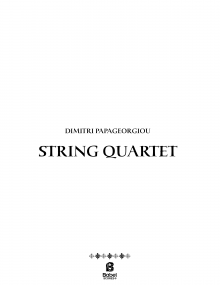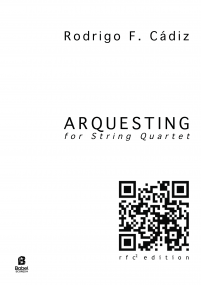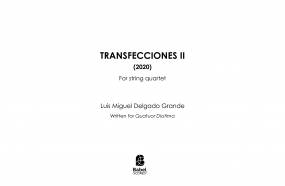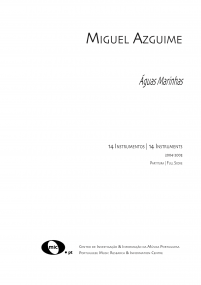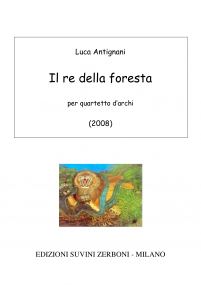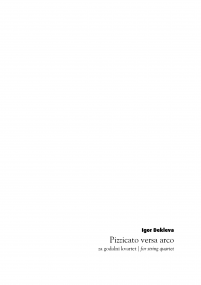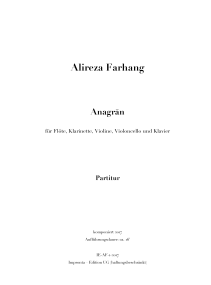Recherche avancée
a complete history of music
for string quartet and electronics
dedicated to JACK quartet
dedicated to JACK quartet
11,00 €
Version numérique (+0,00 €) à télécharger
Version papier (+16,20 € impression et livraison ). Colissimo7-14 days aprox.
Chez BabelScores, quand vous achetez une partition, vous pouvez ensuite contacter directement le compositeur ici même !
Caractéristiques
Region
North America (Canada - USA)
Estimated Duration
16 - 20min
Date
2020
ISMN : 979-0-2325-6348-0
Notes sur cette pièce This long-scale, multi-movement work for string quartet and live multichannel electronics (which can alternatively be performed in a stereo version) was commissioned by Wittener Tage für neue Kammermusik for JACK quartet, to be premièred in April 2020. Only a short, pre-recorded excerpt (see youtube link) could be broadcast at that time due to the pandemic. It then received its pre-première by JACK quartet at Merkin Hall in Spring 2022, following a residency at EMPAC to develop the live electronics, and is scheduled to be officially première at Wittener Tage für neue Kammermusik in 2023.
The tongue-in-cheek title is a reference to my practice of compositionally "interpreting" or "representing" pre-existing musical utterances. Tim Rutherford-Johnson describes this process as follows:
For several years now Alessandrini has started her pieces analytically. She begins with a pre-existing work, usually something canonic; examples include Purcell’s “Music for the Funeral of Queen Mary,” Mozart’s “Dissonance” String Quartet K.465, and Schoenberg’s “Verklärte Nacht.” Then she collects recordings of the pieces and superimposes them, digitally adjusting the files so that even though the originals are all played at different speeds, in her composite version everything lines up. This preliminary model is then re-transcribed— selectively and creatively—to create the score.
In this (my sixth) quartet, I shift the focus recursively towards analysis and representation in themselves. In Appendix 2, for instance, the material is derived from the Adagio movement of Schubert’s Quintet in C major (Op 163), but by combining successive iterations of the same material in different key areas, a Ravel- or Debussy-like succession of harmonies, full of parallel fifths, is achieved.
In other movements, I am re-representing works that I have already interpreted in previous compositions, or interpreting works I previously interpreted by re-representing my compositions representing them. In other movements, I attempt to use analysis, reduction and representation techniques derived from film and visual art: for instance, the way the colors in each single movie frame - or any other image - can be averaged into a single distinct shade; or Olafur Eliasson's arrangement of all of the colors of a painting, ordered by proximity to one another, into a ring representing their gradations into one another. By re-ordering the original work's constituent elements, I am seeking to distill something of it which can only be seen through this change of perspective. The distance created by these forms of re- representation foregrounds the act of interpretation itself, making it just as important as - or more so than - the work that is being represented.
Ajouter à une playlist
- Identifiez-vous pour créer une liste
The tongue-in-cheek title is a reference to my practice of compositionally "interpreting" or "representing" pre-existing musical utterances. Tim Rutherford-Johnson describes this process as follows:
For several years now Alessandrini has started her pieces analytically. She begins with a pre-existing work, usually something canonic; examples include Purcell’s “Music for the Funeral of Queen Mary,” Mozart’s “Dissonance” String Quartet K.465, and Schoenberg’s “Verklärte Nacht.” Then she collects recordings of the pieces and superimposes them, digitally adjusting the files so that even though the originals are all played at different speeds, in her composite version everything lines up. This preliminary model is then re-transcribed— selectively and creatively—to create the score.
In this (my sixth) quartet, I shift the focus recursively towards analysis and representation in themselves. In Appendix 2, for instance, the material is derived from the Adagio movement of Schubert’s Quintet in C major (Op 163), but by combining successive iterations of the same material in different key areas, a Ravel- or Debussy-like succession of harmonies, full of parallel fifths, is achieved.
In other movements, I am re-representing works that I have already interpreted in previous compositions, or interpreting works I previously interpreted by re-representing my compositions representing them. In other movements, I attempt to use analysis, reduction and representation techniques derived from film and visual art: for instance, the way the colors in each single movie frame - or any other image - can be averaged into a single distinct shade; or Olafur Eliasson's arrangement of all of the colors of a painting, ordered by proximity to one another, into a ring representing their gradations into one another. By re-ordering the original work's constituent elements, I am seeking to distill something of it which can only be seen through this change of perspective. The distance created by these forms of re- representation foregrounds the act of interpretation itself, making it just as important as - or more so than - the work that is being represented.
Instrumentation
Violin (2)|Viola|Cello
Recording
Youtube scorefollowing recording- A Complete History of Music (Volume 1)- Appendix 2
This recording of a single movement of the piece has a somewhat unusual history- it was composed specifically for JACK quartet in order to be recorded remotely for a WDR3 broadcast in lieu of the live première of the much longer
This recording of a single movement of the piece has a somewhat unusual history- it was composed specifically for JACK quartet in order to be recorded remotely for a WDR3 broadcast in lieu of the live première of the much longer
Score Details
Format - A3 / Tabloid
Pages - 28
Pages - 28





